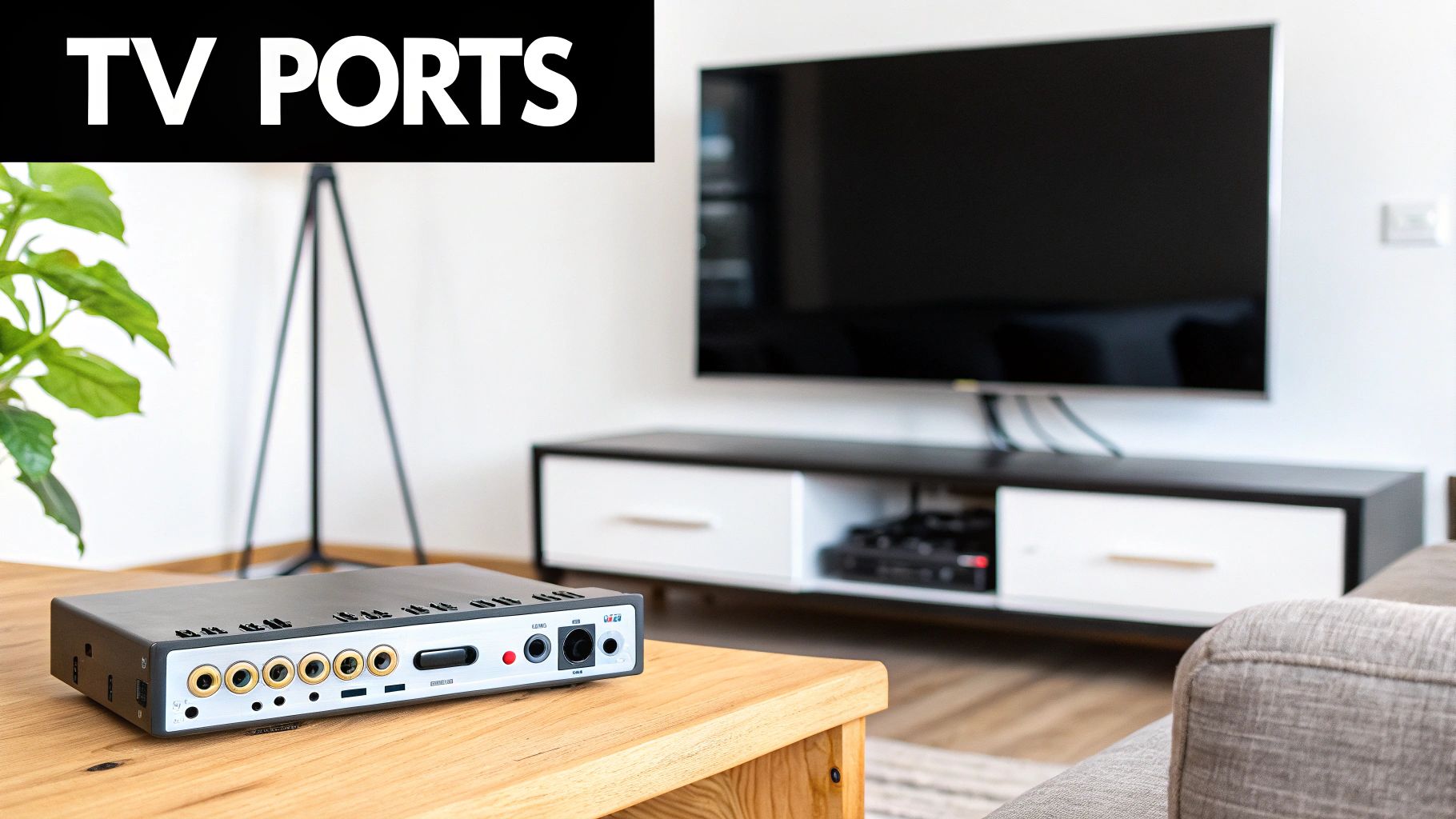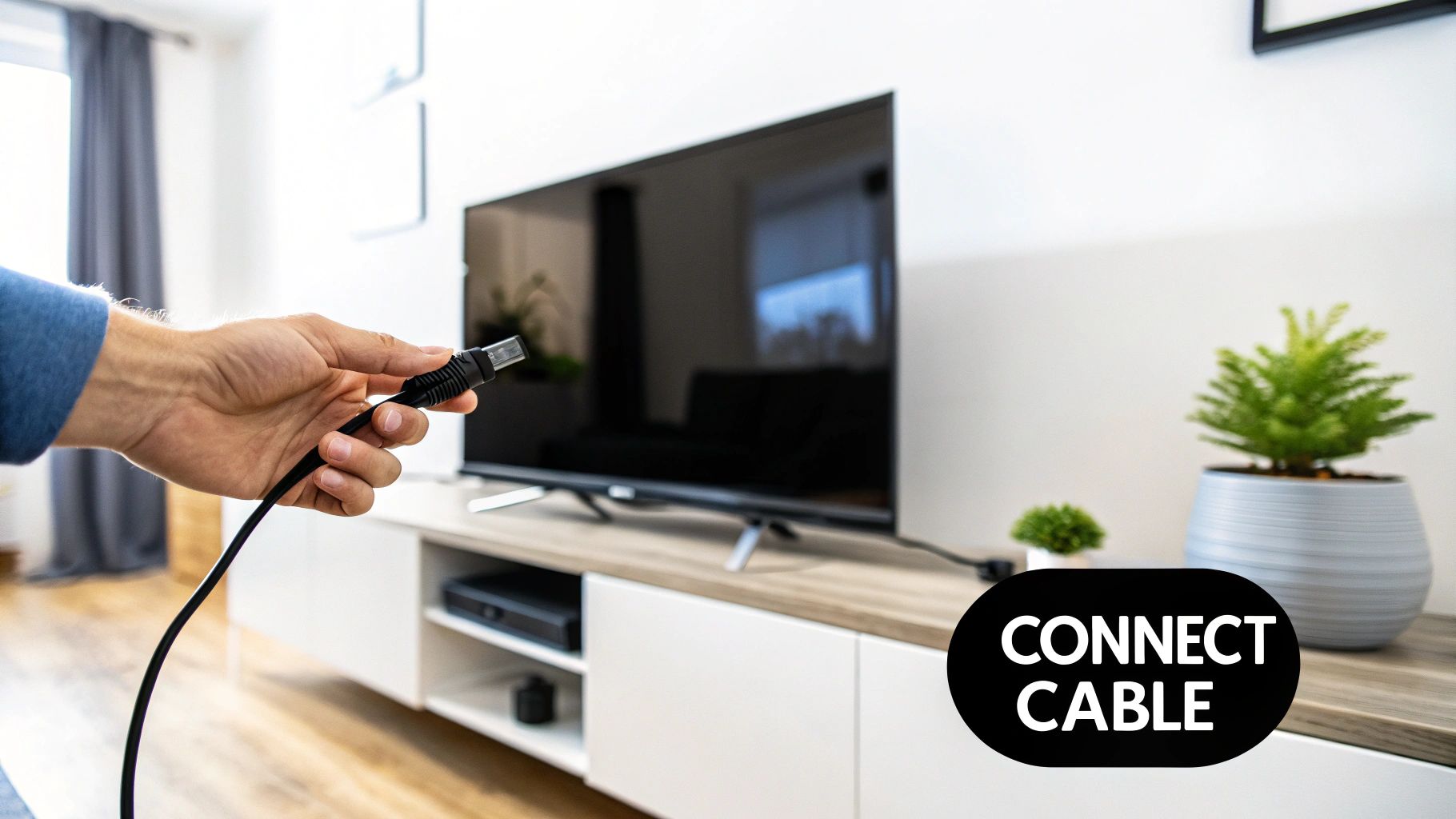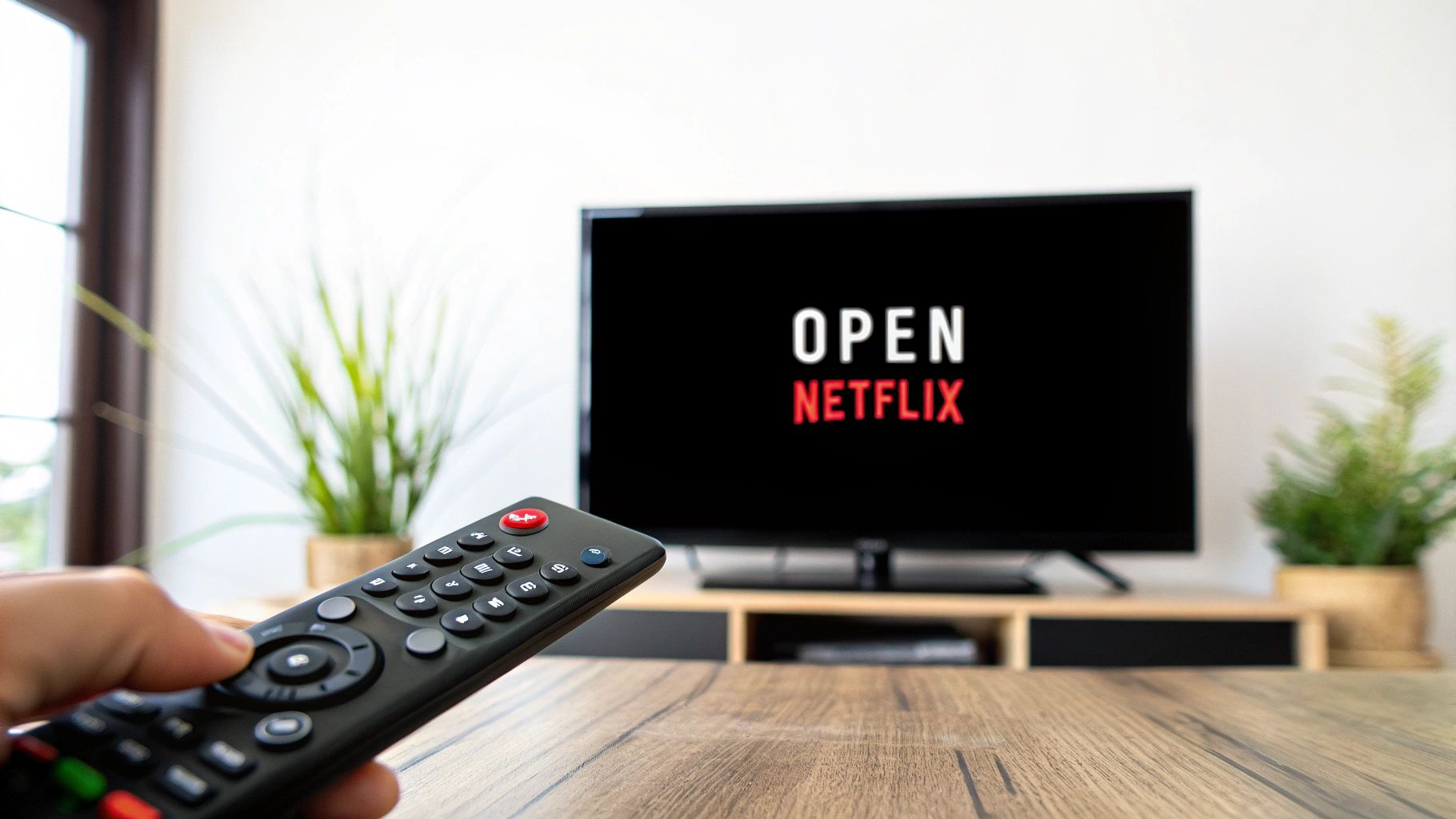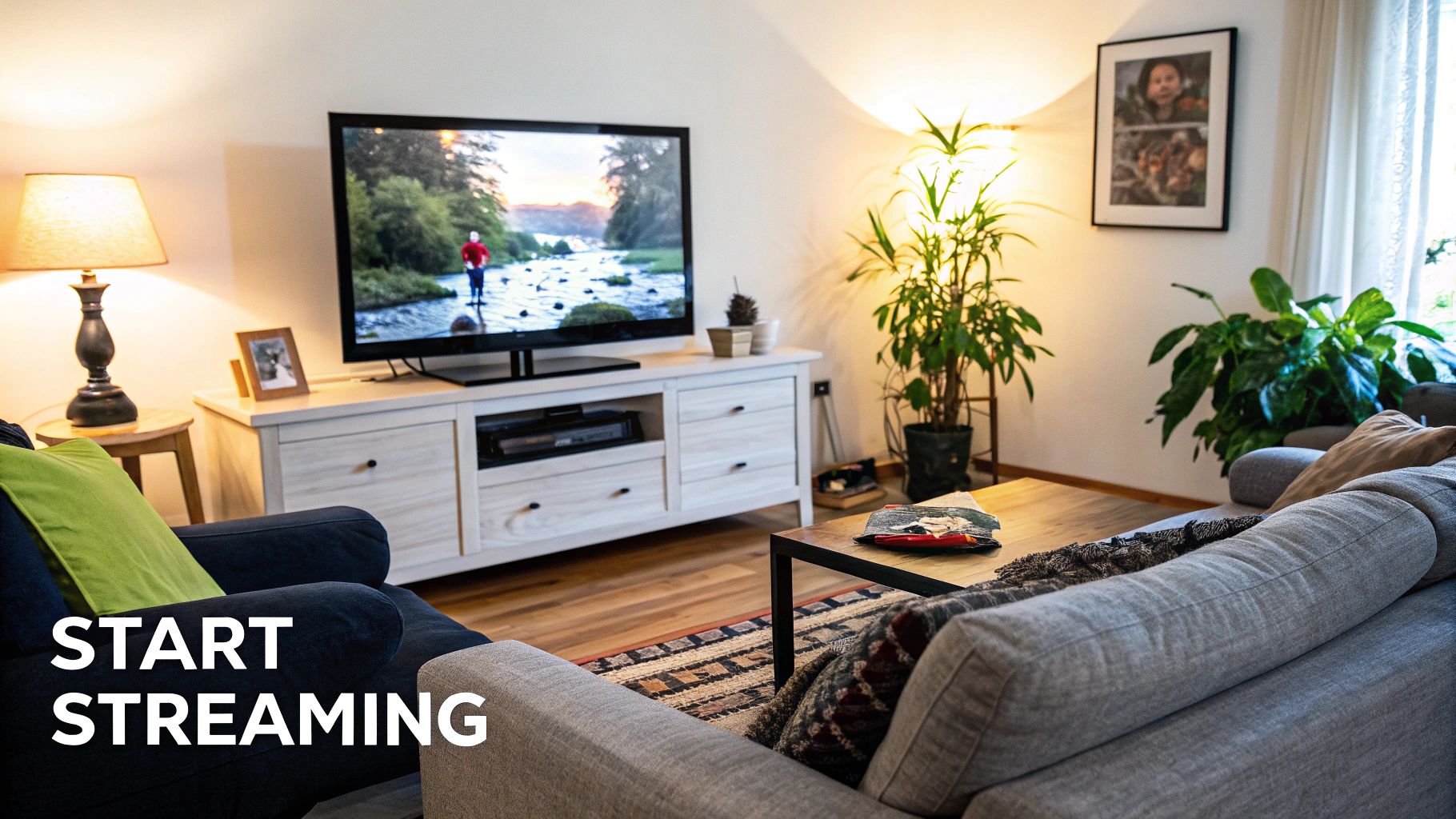
How to hook up netflix to tv: Fast Setup Tips
Share
The Evolution of Netflix: Why Your TV Screen Matters

Entertainment consumption has undergone a dramatic transformation. Remember the days of scheduling your life around TV programming? Now, services like Netflix provide on-demand access to an extensive content library. This shift toward personalized viewing has positioned the TV screen as the central hub of home entertainment. Connecting Netflix to your TV is now key to unlocking the full potential of this streaming service.
From DVDs to Streaming Powerhouse
Netflix's journey has been instrumental in this evolution. Launched in 1997 as a DVD rental service, Netflix disrupted the home entertainment industry. It offered users unprecedented control over their viewing, setting the stage for the streaming age.
By 2007, Netflix began its transition to streaming. This amplified user control even further, allowing access to content across various devices, especially TVs. Today, Netflix commands a staggering 9.39% of all global downstream traffic. This statistic highlights how deeply embedded streaming has become in our internet usage. Learn more about this trend in this research paper: Netflix and Streaming Dominance. This shift in viewing habits emphasizes the importance of optimizing your TV connection for maximum enjoyment.
The Benefits of the Big Screen
Why does the TV screen play such a vital role in the Netflix experience? Simply put, larger screens offer a more immersive viewing experience. Compare watching a movie on your phone to watching it on a large, high-definition TV. The difference is significant.
Larger displays enhance visual details, drawing you deeper into the story. They also provide a shared viewing experience that strengthens connections with others. Netflix recognizes this and has made significant investments in optimizing its platform for larger screens.
The Psychology of Watching TV
The psychology of viewing also plays a significant role. Watching on a TV screen is generally a more passive, relaxing experience. It encourages you to unwind and immerse yourself in the content.
Mobile viewing, in contrast, often occurs on the go and in shorter bursts. This makes it less conducive to engaging deeply with longer-form content like movies or TV series. This fundamental difference in viewing habits leads to a more fulfilling experience on the big screen. Research consistently shows a preference for TV screen viewing across various demographics, particularly for movies and TV shows. Explore more on viewing habits here: Blog Sitemap. This reinforces the ongoing need to understand how to connect Netflix to your TV effectively.
Enhancing Your Netflix Experience
Understanding Netflix's evolution and the importance of the TV screen lays the groundwork for selecting the optimal connection method for your specific setup. Each method, from Smart TVs to gaming consoles, presents unique advantages and disadvantages. Choosing the right one can significantly enhance your Netflix viewing experience.
Smart TV Connection: Direct Access to Netflix

Smart TVs have revolutionized how we access Netflix. This integration has made the TV screen the go-to choice for millions. As of 2023, over 132 million unique viewers in the U.S. alone prefer watching Netflix on their TVs.
This widespread adoption is further highlighted by Netflix's substantial global subscriber base, reaching 277.6 million by 2024. For a deeper dive into these figures, check out these Netflix Viewership Statistics. But with various smart TV platforms available, navigating the setup process can sometimes feel a bit overwhelming.
Navigating Different Smart TV Platforms
Each smart TV manufacturer has its own interface and setup process for apps like Netflix. This can occasionally make the connection process a bit more complicated. Let's break down some of the most common brands.
To help visualize the differences, let's look at a comparison table:
Smart TV Netflix Setup Comparison
| TV Brand | Netflix Pre-installed? | Setup Difficulty | Special Features | Common Issues |
|---|---|---|---|---|
| Samsung | Often | Easy | Tizen OS integration, often a dedicated remote button | Occasional app crashes |
| LG | Often | Easy | webOS integration, usually a dedicated remote button | Software updates can sometimes cause temporary issues |
| Sony | Usually | Easy | Android TV integration, access through the Google Play Store | Requires a Google account |
| Vizio | Sometimes | Varies | SmartCast OS, Chromecast built-in | Network connectivity problems |
| TCL | Sometimes | Varies | Roku TV or Android TV, depending on the model | Remote control issues |
| Hisense | Sometimes | Varies | Vidaa OS or Android TV, depending on the model | App store limitations |
As you can see, the setup process can vary quite a bit between brands. Consulting your TV's user manual is always the best way to find specific instructions.
Optimizing Picture Settings for Netflix
Once Netflix is set up, you can greatly improve your viewing experience by adjusting your TV's picture settings. This can significantly enhance how you perceive the content.
- Brightness and Contrast: Finding the right balance between brightness and contrast is key for a clear picture. Too much brightness can wash out detail, especially in darker scenes.
- Color: Adjusting the color settings can impact the vibrancy and realism of what you're watching. Experiment to find what looks best to you.
- Sharpness: While a bit of sharpness can enhance details, too much can create unwanted artifacts. A little tweaking can go a long way.
These simple adjustments can make a noticeable difference. Your TV's settings menu likely has even more customization options to explore.
Troubleshooting Common Connectivity Issues
Even with a smooth setup, occasional connection hiccups can happen. Knowing a few basic troubleshooting steps can be a real lifesaver.
- Check Your Internet Connection: Ensure your internet connection is strong and stable. A weak signal can lead to buffering or interruptions.
- Restart Your TV and Router: This simple step can often resolve temporary software glitches that interfere with streaming.
- Update Your TV's Software: Outdated software can cause compatibility problems. Keeping your TV's firmware current is always recommended.
- Clear the Netflix App Cache: Clearing the app's cached data can sometimes resolve performance problems. The method for doing this depends on your TV's operating system.
These tips can often solve common issues quickly. For more persistent problems, checking your TV's user manual or contacting the manufacturer's support is a good next step.
Advanced Smart TV Features for Netflix
Many smart TVs have advanced features that elevate the Netflix experience even further, adding more control and convenience.
- Voice Commands: Some TVs have voice control, allowing you to search, control playback, and navigate the Netflix app with your voice.
- Dedicated Netflix Buttons: Many remotes have dedicated Netflix buttons for instant access. No more scrolling through menus!
These features simplify your Netflix interaction. They make navigating and enjoying your content that much easier, solidifying the TV as your central entertainment hub.
Streaming Devices: The Ultimate Netflix Connection Solution

Streaming devices offer a versatile way to connect Netflix to your TV. These small devices plug into your TV's HDMI port, granting access to a world of streaming entertainment. They're compatible with nearly any TV, making them a great option for both older and newer models. This broad compatibility has certainly played a part in Netflix's impressive growth.
As of 2024, Netflix boasts 93.9 million subscribers in the Europe, Middle East, and Africa region alone. Furthermore, Netflix accounts for a significant 26.09% of all downstream traffic in the region. This speaks volumes about its popularity. For a deeper dive into these numbers, check out these Netflix Usage Statistics. Let's take a closer look at some of the top streaming devices available.
Roku: Simplicity and Affordability
Roku devices are well-regarded for their user-friendly interface and extensive channel selection, including Netflix. They offer a range of models, from basic streaming sticks to more advanced boxes with 4K and HDR support. Setting up a Roku is generally simple, requiring only a connection to your TV and Wi-Fi network. The interface makes browsing and launching Netflix a breeze.
Fire TV Stick: Amazon's Streaming Powerhouse
The Amazon Fire TV Stick is another popular way to access Netflix on your TV. Similar to Roku, it connects to your TV's HDMI port and your home Wi-Fi. A key feature of the Fire TV Stick is its integration with Amazon's Alexa voice assistant. This allows for hands-free control of your Netflix viewing. You can simply ask, "Alexa, open Netflix," and the app will start automatically.
Apple TV: Seamless Integration with the Apple Ecosystem
For users already within the Apple ecosystem, the Apple TV offers a compelling option. It boasts a sleek interface and seamlessly integrates with other Apple devices like iPhones, iPads, and Macs. Sharing content from your Apple devices to your TV is easy thanks to AirPlay. Apple TV also supports high-quality streaming, including 4K and Dolby Vision.
Chromecast: Stream Directly From Your Mobile Device
Chromecast stands out from the other devices because it doesn't have its own on-screen interface. Instead, you "cast" content from your phone, tablet, or computer directly to your TV. This offers a lot of flexibility, effectively turning your mobile device into a remote control. It's particularly convenient for quickly sharing photos or videos from your phone to the big screen. However, some users might still prefer a dedicated remote for a more traditional TV experience.
Choosing the Right Streaming Device
The best streaming device for you depends on your needs and preferences. Think about your budget, your current tech setup, and the features that are most important to you.
Here's a quick comparison:
| Feature | Roku | Fire TV Stick | Apple TV | Chromecast |
|---|---|---|---|---|
| Price | Affordable | Affordable | Premium | Affordable |
| Interface | Simple and easy to use | Integrated with Alexa | Sleek and Apple-centric | Controlled from mobile device |
| 4K Support | Select models | Select models | Yes | Yes |
| HDR Support | Select models | Select models | Yes | Yes |
For more information on related tech topics, you can explore our sitemap. Regardless of which device you choose, streaming devices provide a convenient and effective solution for connecting Netflix to your TV, opening up a vast library of entertainment. They’ve become a common fixture in homes, providing a simple way to improve the TV viewing experience.
Gaming Consoles: The Overlooked Netflix Powerhouses

Your gaming console isn't just for gaming anymore. Think of it as a powerful Netflix streaming platform just waiting to be discovered. These consoles offer a surprising alternative to dedicated streaming devices like Roku or Amazon Fire TV, and even Smart TVs, especially in situations where a dedicated device might not be readily available. Whether you're using a PlayStation, Xbox, or a Nintendo Switch, you have a robust system ready to connect Netflix to your TV.
Optimizing Your Console for Netflix
Each console offers a slightly different setup process and interface. PlayStation users, for example, can locate the Netflix app in the TV & Video section of their home screen. Xbox users can access it through the Microsoft Store.
Regardless of your console, make sure the Netflix app is up to date. This ensures optimal performance, giving you access to the newest features and important bug fixes.
Also, don't forget about your console's video and audio settings. Adjusting these settings, such as resolution, color depth, and sound output, can dramatically improve your viewing experience. Many modern consoles now support 4K resolution and HDR, offering stunning visuals if your TV is compatible.
Controller Shortcuts for Netflix Navigation
Mastering your console's controller can significantly improve your Netflix navigation. Using the D-pad for directional control and buttons like X (PlayStation) or A (Xbox) for selection are the basics. However, many consoles also offer hidden shortcuts that can truly enhance your Netflix experience.
- Quick Pausing and Playing: Dedicated pause/play buttons often eliminate the need to navigate on-screen menus.
- Fast Forwarding and Rewinding: Shoulder buttons or triggers often allow for quick skipping forward or backward without visually interrupting playback.
- Volume Control: Many controllers include volume buttons, making audio adjustments a breeze.
By discovering and using these shortcuts, you can streamline your navigation within the Netflix interface. Your gaming controller becomes a personalized remote control, perfectly suited for your viewing habits.
Audio Optimization for Immersive Viewing
Gaming consoles typically have advanced audio capabilities that can elevate your Netflix experience. Many support surround sound formats like Dolby Atmos or DTS:X, creating a truly immersive audio environment.
This means connecting Netflix through your console can provide a richer, more dynamic sound experience than some Smart TVs or basic streaming devices. Explore your console's audio settings to fine-tune the output for your particular speaker setup and preferences.
Platform-Specific Advantages for Netflix
Different consoles cater to different viewing needs. The PlayStation 5 and Xbox Series X, with their powerful hardware, excel at delivering high-quality 4K HDR content, perfect for dedicated home theater setups. The Nintendo Switch, due to its portability, offers a unique advantage – the ability to seamlessly transition from watching on your TV to continuing your show on the go.
No matter your console of choice, using it for Netflix provides more than just basic viewing. It unlocks the potential for enhanced performance, simplified navigation, and immersive audio, transforming your gaming console into a true entertainment powerhouse.
HDMI Connection: Turning Your Computer Into Netflix Central
Connecting your computer to your TV unlocks a world of Netflix possibilities beyond dedicated devices. This setup offers flexibility and control, transforming your computer into a powerful entertainment hub. However, understanding HDMI connections is key for optimal performance.
Choosing the Right HDMI Cable
Not all HDMI cables are the same. Different types offer varying performance levels. For standard HD viewing, a high-speed HDMI cable is sufficient. But for 4K Ultra HD and HDR content, a premium high-speed HDMI cable or an ultra high-speed HDMI cable is necessary. These support higher bandwidth for the crispest picture and most vibrant colors. Think of it like plumbing: a larger pipe allows more water to flow smoothly. Similarly, a higher-bandwidth HDMI cable transmits more data for a higher-quality picture.
Creating a Comfortable Viewing Space
Connecting Netflix to your TV from your computer is more than just plugging in a cable. Consider your physical setup. Comfortable viewing distance and proper screen placement are essential. Position your computer to avoid straining or constantly adjusting your seating. This creates a more enjoyable and sustainable viewing experience, especially for movie nights or binge-watching.
Calibrating Your Display
Consistent color between your computer and TV is crucial. Your computer's display settings may not translate perfectly to your TV, resulting in washed-out or overly saturated colors. Adjusting your TV’s picture settings—brightness, contrast, and color—is key. Many TVs offer pre-calibrated picture modes for movies or streaming, simplifying the process.
Keyboard Shortcuts for Easy Control
Controlling Netflix on your TV from your computer doesn't require a wireless mouse. Keyboard shortcuts offer convenient playback control. The spacebar pauses and plays, while the arrow keys navigate. Learning these shortcuts streamlines your viewing experience, making your computer a true Netflix command center.
This strategy is especially relevant given Netflix’s financial success and consumer demand for accessible content. In 2024, Netflix generated $39 billion in revenue, a 15.7% increase. This growth is partly due to their $16 billion content investment. See more: Netflix Financial Statistics. This highlights the importance of optimizing viewing experiences across devices.
Optimizing Browser and Audio
For the best streaming, configure your web browser. Disabling unnecessary extensions and clearing your browser cache can improve loading times and reduce buffering. Routing audio through your TV’s speakers, instead of your computer’s, often provides a superior audio experience. Adjust this in your computer's sound settings.
Troubleshooting HDMI Audio
Sometimes, an HDMI connection doesn't automatically route audio. Check your computer’s sound settings, ensuring your TV is the default audio output. If issues persist, restart both your computer and TV. This can resolve temporary software glitches affecting the audio signal. By addressing these aspects, you create a personalized Netflix hub, maximizing convenience and viewing enjoyment.
Mobile Casting: Netflix In Your Pocket, Displayed On Your TV
Mobile casting offers a convenient way to enjoy the immersive experience of watching Netflix on your TV while still using the familiar interface of your phone. Browse for content on your phone and then effortlessly send it to your TV's larger screen. It's a popular method for connecting Netflix to a TV.
The Psychology of Browsing Vs. Watching
Why do people prefer browsing on their phones but watching on their TVs? Studies show that the portability of mobile devices makes them perfect for quick searches and browsing. However, TVs offer a more engaging viewing experience with their larger screens and better sound, especially for longer content. Casting combines the strengths of both devices.
Establishing A Stable Casting Connection
A stable connection is essential for seamless casting. Make sure both your mobile device and smart TV are connected to the same Wi-Fi network. This shared network allows your phone and TV to communicate. It's similar to two walkie-talkies needing to be on the same channel.
Next, open the Netflix app on both your phone and TV. Locate the cast icon, usually a screen with a Wi-Fi signal. Tap this icon on your phone and choose your TV from the device list. This starts the casting process, sending the video stream to your TV.
Optimizing For Android and iOS
While the basics of casting are the same, there are platform-specific tweaks. On Android devices, ensure the "Wireless Display" or "Cast" setting is enabled. For iOS devices using AirPlay, make sure it's turned on. These system settings are vital for casting. Checking them beforehand can prevent troubleshooting later.
Maintaining Casting Quality During Peak Wi-Fi Usage
Heavy internet use can impact casting quality. If other devices are streaming or gaming, it can strain your Wi-Fi network. Prioritize your casting device in your router settings. Many routers have Quality of Service (QoS) settings, allowing you to give preference to specific devices or apps, ensuring your Netflix stream gets enough bandwidth.
Troubleshooting Disconnection Issues
Occasional disconnections can happen. Restarting your router or TV often solves the problem. If issues persist, check for Netflix app updates on both devices, as outdated software can cause instability. As a last resort, try resetting your Smart TV to factory settings and reinstalling the Netflix app to resolve persistent software conflicts.
Conserving Battery While Casting
Casting uses battery power. To avoid your phone dying, lower its screen brightness. Connect your phone to a charger while casting, particularly for long movies or shows. Closing unnecessary background apps on your phone can also help conserve power and free up resources.
Troubleshooting: Solving Netflix Connection Challenges
Connecting to Netflix on your TV is usually straightforward, but occasionally, you might run into some bumps in the road. Don't worry, most of these issues are easily resolved with a little troubleshooting know-how. Understanding the common problems and their solutions can quickly get you back to binge-watching.
Identifying the Source of the Problem
The first step is figuring out where the problem lies. Is it your equipment, your internet connection, or Netflix itself? Try accessing other online services like YouTube. If YouTube works fine, the issue is likely with Netflix or your specific setup. If other services are also down, then your internet connection is probably the culprit.
Common Connection Problems and Solutions
To help you quickly diagnose and fix common Netflix connection problems, I've put together a handy troubleshooting guide. It covers a range of issues and offers solutions for various devices.
Before we dive in, here’s a table outlining common issues and their fixes:
Netflix Connection Troubleshooting Guide
| Problem | Possible Causes | Solution Steps | Applies To |
|---|---|---|---|
| Buffering or Low-Quality Video | Slow internet speed, too many devices using Wi-Fi, Netflix app issues | Check internet speed, disconnect other devices, restart your router, update/reinstall Netflix app | All Devices |
| "Network Error" Message | Internet connectivity problems, Netflix service outage | Check your internet connection, visit the Netflix website to check for service outages, restart your TV/device | All Devices |
| App Crashing or Freezing | App glitches, outdated software | Clear the app cache, update the app, reinstall the app | Smart TVs, Streaming Devices, Gaming Consoles |
| Casting Issues | Network problems, device incompatibility, outdated apps | Check network connection, ensure devices are compatible, update casting apps and Netflix app | Mobile Devices, Smart TVs |
| Login Problems | Incorrect password, account issues | Verify your login details, check your Netflix account status | All Devices |
This table provides a quick overview of the typical issues you might encounter. In the following sections, we'll delve deeper into some of the most frequent problems and their solutions.
Resolving Buffering Problems
Buffering is arguably the most annoying streaming issue. If you're constantly seeing that spinning wheel, start by checking your internet speed. Netflix recommends a minimum speed of 3 Mbps for SD quality, 5 Mbps for HD, and 25 Mbps for 4K Ultra HD. If your speed is fine, try disconnecting other devices from your Wi-Fi to free up bandwidth. Restarting your router can also help resolve temporary network hiccups.
Managing Your Netflix Account
Sometimes, connection problems originate from your Netflix account. Make sure your account is active and in good standing. Double-check your login details, especially your password. If you’ve recently updated it, ensure it's synced across all your devices.
Bandwidth Management for Multiple Devices
If you live in a household with multiple internet users, competition for bandwidth can significantly impact your streaming experience. Consider implementing bandwidth management strategies. Some routers allow you to prioritize traffic to specific devices, ensuring your streaming device gets the bandwidth it needs. You could also schedule bandwidth-heavy activities like large downloads for off-peak hours.
Maintaining Your Connection
Just like any technology, your streaming setup benefits from regular maintenance. Keeping your Netflix app, device firmware, and router software updated can prevent future problems. This proactive approach saves you from troubleshooting headaches down the line.
By following these troubleshooting steps and performing regular maintenance, you can ensure a smooth and enjoyable Netflix experience on your TV. These solutions will help optimize your streaming quality, minimize interruptions, and maximize your viewing pleasure. Ready for a more affordable way to enjoy premium subscriptions? Check out AccountShare at https://accountshare.ai and explore the benefits of shared accounts.
